Analysis Theories, Principles, Models of Learning Preferences : Assignment
Added on 2020-10-22
34 Pages9367 Words354 Views
Table of Contents
INTRODUCTION...........................................................................................................................2
TASK 1............................................................................................................................................2
A. Analysis theories, principles, models of learning and models of learning preferences.........2
B. Explaining ways in which theories, principles and models of learning can be applied to
teaching and assessment..............................................................................................................7
C. Analysing individual learning preferences that enables inclusive teaching, learning and
assessment...................................................................................................................................8
TASK 2..........................................................................................................................................10
A. Analysis of theories, principles and models of communication...........................................10
B. Explaining ways in which theories, principles and models of communication can be
applied to teaching, learning and assessment............................................................................12
TASK 3..........................................................................................................................................13
A. Analysing theories, principles and models of assessment....................................................13
B. Explaining ways in which theories, models and principles of assessment can be applied to
learning......................................................................................................................................15
C. Choosing assessment method from teaching practice portfolio...........................................17
D. Evaluating effectiveness in enabling learning and progression for different learners.........18
TASK 4..........................................................................................................................................18
A. Analysing theories and models of curriculum development................................................18
B. Explaining ways in which theories and models of curriculum development can be applied
in own area of specialism..........................................................................................................22
TASK 5..........................................................................................................................................23
A. Analysing theories and models of reflection and evaluation...............................................23
B. Application of theories and models of reflection and evaluation in reflective account.......30
CONCLUSION..............................................................................................................................32
REFERENCES..............................................................................................................................34
INTRODUCTION...........................................................................................................................2
TASK 1............................................................................................................................................2
A. Analysis theories, principles, models of learning and models of learning preferences.........2
B. Explaining ways in which theories, principles and models of learning can be applied to
teaching and assessment..............................................................................................................7
C. Analysing individual learning preferences that enables inclusive teaching, learning and
assessment...................................................................................................................................8
TASK 2..........................................................................................................................................10
A. Analysis of theories, principles and models of communication...........................................10
B. Explaining ways in which theories, principles and models of communication can be
applied to teaching, learning and assessment............................................................................12
TASK 3..........................................................................................................................................13
A. Analysing theories, principles and models of assessment....................................................13
B. Explaining ways in which theories, models and principles of assessment can be applied to
learning......................................................................................................................................15
C. Choosing assessment method from teaching practice portfolio...........................................17
D. Evaluating effectiveness in enabling learning and progression for different learners.........18
TASK 4..........................................................................................................................................18
A. Analysing theories and models of curriculum development................................................18
B. Explaining ways in which theories and models of curriculum development can be applied
in own area of specialism..........................................................................................................22
TASK 5..........................................................................................................................................23
A. Analysing theories and models of reflection and evaluation...............................................23
B. Application of theories and models of reflection and evaluation in reflective account.......30
CONCLUSION..............................................................................................................................32
REFERENCES..............................................................................................................................34

INTRODUCTION
Various theories, models and principles of learning helps in
learning and improving knowledge. Different models and
principles of learning preferences guides ways of learning
preferences (Amanchukwu, Stanley and Ololube, 2015). Different
ways of learning or style helps different people to acquire
knowledge and skills. Styles of learning are termed as
preferences. This report includes various theories and models
which are used in education and training. Application of these
principles and models in education and training is shown in the
report. The report explains how learner’s preferences needs to be
taken into account according to inclusive learning and teaching.
Furthermore, this study will also examine the models and
principles of communication which can be applied to teaching,
learning and assessment. In addition to this the report will discuss
assessments that helps in improving the learning through
relevant examples along with the relationship among each
assessment and learning.
TASK 1
A. Analysis theories, principles, models of learning and models of
learning preferences.
Learning is the process that aims at acquiring new skills and
knowledge or developing current skills and knowledge (Barnlund,
2017). Learners uses these models and theories to improve and
modify existing behaviours, knowledge, skills, preferences and
values. The process and procedure involved in learning is studied
2
Various theories, models and principles of learning helps in
learning and improving knowledge. Different models and
principles of learning preferences guides ways of learning
preferences (Amanchukwu, Stanley and Ololube, 2015). Different
ways of learning or style helps different people to acquire
knowledge and skills. Styles of learning are termed as
preferences. This report includes various theories and models
which are used in education and training. Application of these
principles and models in education and training is shown in the
report. The report explains how learner’s preferences needs to be
taken into account according to inclusive learning and teaching.
Furthermore, this study will also examine the models and
principles of communication which can be applied to teaching,
learning and assessment. In addition to this the report will discuss
assessments that helps in improving the learning through
relevant examples along with the relationship among each
assessment and learning.
TASK 1
A. Analysis theories, principles, models of learning and models of
learning preferences.
Learning is the process that aims at acquiring new skills and
knowledge or developing current skills and knowledge (Barnlund,
2017). Learners uses these models and theories to improve and
modify existing behaviours, knowledge, skills, preferences and
values. The process and procedure involved in learning is studied
2
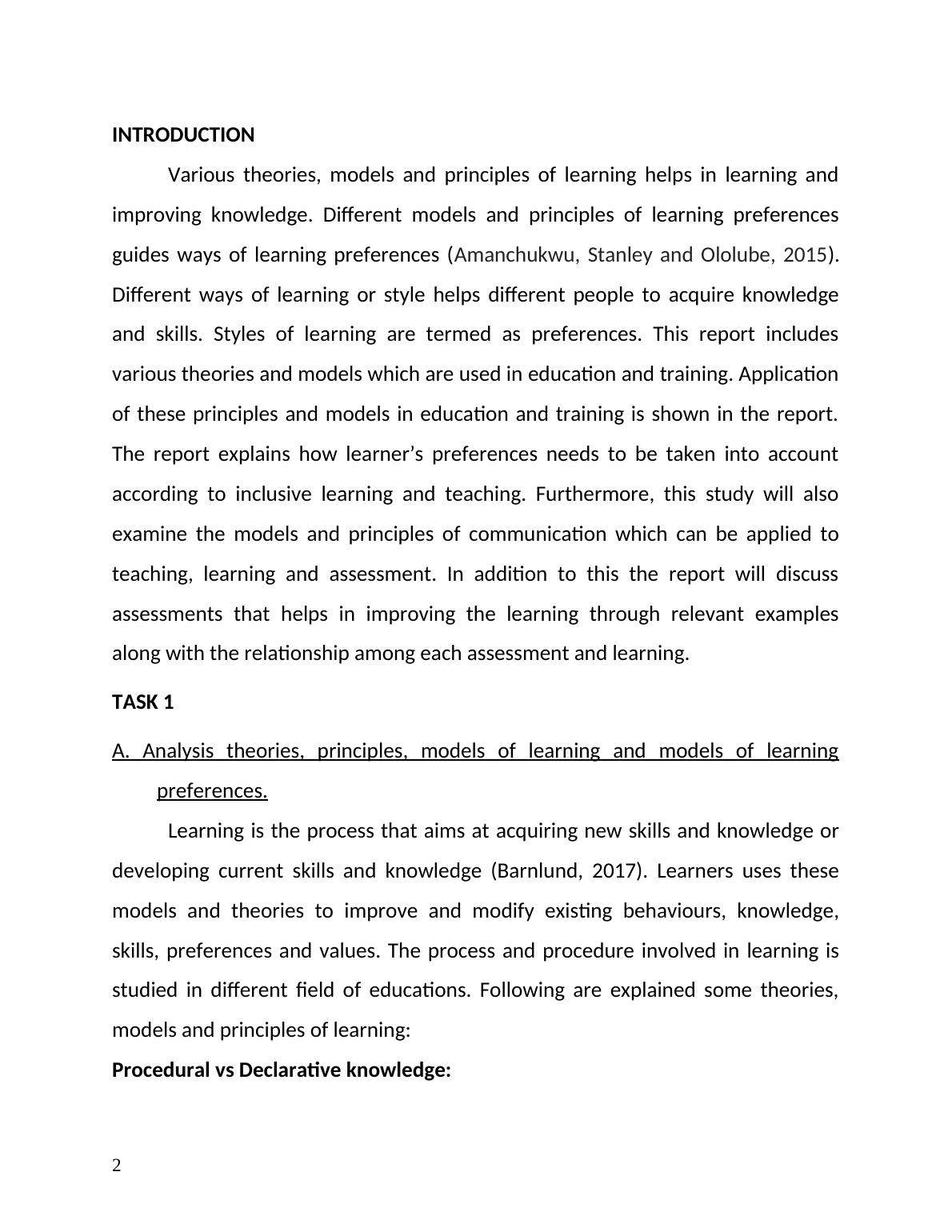
in different field of educations. Following are explained some
theories, models and principles of learning:
Procedural vs Declarative knowledge:
Person with declarative knowledge or procedural knowledge
effectively becomes skilled in problem solving. Declarative
knowledge refers that factual information or data which is stored
in memory that is also known to be static in nature. Declarative
knowledge is very conscious and often verbalized. Whereas,
procedural knowledge teaches person to ways for doing
something. In this type of knowledge person may not be able to
explain how to do it. For example, riding a bicycle. The procedural
knowledge implicit learning, which learner is not aware of.
Skills development: It is one of the five major categories of
learning, verbal information, cognitive strategies, motor skills and
attitudes. Various external and internal conditions are essential
for each and every type of learning. For example, in order to learn
cognitive strategies there must be a probability to practice
development of new solutions to issues or problems. It is essential
to learn attitudes and along with this it is also necessary for the
learner to get exposed to a persuasive argument or credible role
model. Skill development is very important part of learning which
is improved through assessment. Each and every skill needs to be
improved and developed with the help of different methods in
order to achieve a overall growth.
Behaviourist
3
theories, models and principles of learning:
Procedural vs Declarative knowledge:
Person with declarative knowledge or procedural knowledge
effectively becomes skilled in problem solving. Declarative
knowledge refers that factual information or data which is stored
in memory that is also known to be static in nature. Declarative
knowledge is very conscious and often verbalized. Whereas,
procedural knowledge teaches person to ways for doing
something. In this type of knowledge person may not be able to
explain how to do it. For example, riding a bicycle. The procedural
knowledge implicit learning, which learner is not aware of.
Skills development: It is one of the five major categories of
learning, verbal information, cognitive strategies, motor skills and
attitudes. Various external and internal conditions are essential
for each and every type of learning. For example, in order to learn
cognitive strategies there must be a probability to practice
development of new solutions to issues or problems. It is essential
to learn attitudes and along with this it is also necessary for the
learner to get exposed to a persuasive argument or credible role
model. Skill development is very important part of learning which
is improved through assessment. Each and every skill needs to be
improved and developed with the help of different methods in
order to achieve a overall growth.
Behaviourist
3
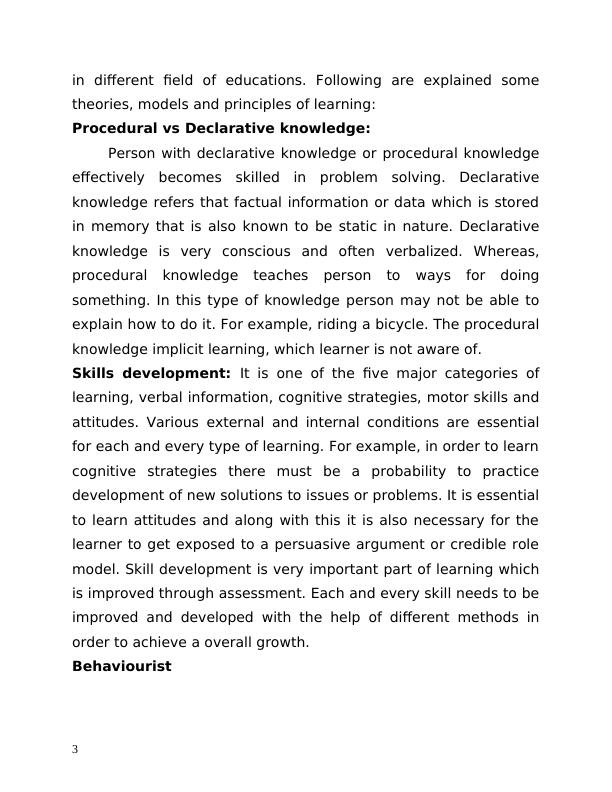
This theory named behaviourism believes that knowledge in
people is existed independently and outside them. The learning
process under this theory is based on observable changes in
behaviour. This is the theory whose learning is based on idea that
all behaviours are acquired through process of conditioning. Thus,
this occurs through interaction with that of environment. The
learning process begins when learner reacts to stimulus that is
present in an environment. This model has been further criticised
for being too dimensional in its understanding in terms of
behaviour. This theory is used by someone when they have to
reward or punish the particular individual. The main consequence
of this theory is that it lacks in preparing the learner in terms of
solving problems or thinking in creative manner. They generally
do what are being told to do rather than taking initiative in
improving things.
Cognitivist
This theory is basically based on the thought process behind
behaviour. It is also based on some kind of idea that human
process respond to the process of the information that they
receive rather than responding to stimuli of environment. There is
no requirement of an outward exhibition in terms of learning, but
has its focus mainly on the internal process and also connections
that may take place while the process of learning takes place.
Humanist
This theory basically states that individual must have ability
in order to search for meanings in order to develop themselves. In
4
people is existed independently and outside them. The learning
process under this theory is based on observable changes in
behaviour. This is the theory whose learning is based on idea that
all behaviours are acquired through process of conditioning. Thus,
this occurs through interaction with that of environment. The
learning process begins when learner reacts to stimulus that is
present in an environment. This model has been further criticised
for being too dimensional in its understanding in terms of
behaviour. This theory is used by someone when they have to
reward or punish the particular individual. The main consequence
of this theory is that it lacks in preparing the learner in terms of
solving problems or thinking in creative manner. They generally
do what are being told to do rather than taking initiative in
improving things.
Cognitivist
This theory is basically based on the thought process behind
behaviour. It is also based on some kind of idea that human
process respond to the process of the information that they
receive rather than responding to stimuli of environment. There is
no requirement of an outward exhibition in terms of learning, but
has its focus mainly on the internal process and also connections
that may take place while the process of learning takes place.
Humanist
This theory basically states that individual must have ability
in order to search for meanings in order to develop themselves. In
4
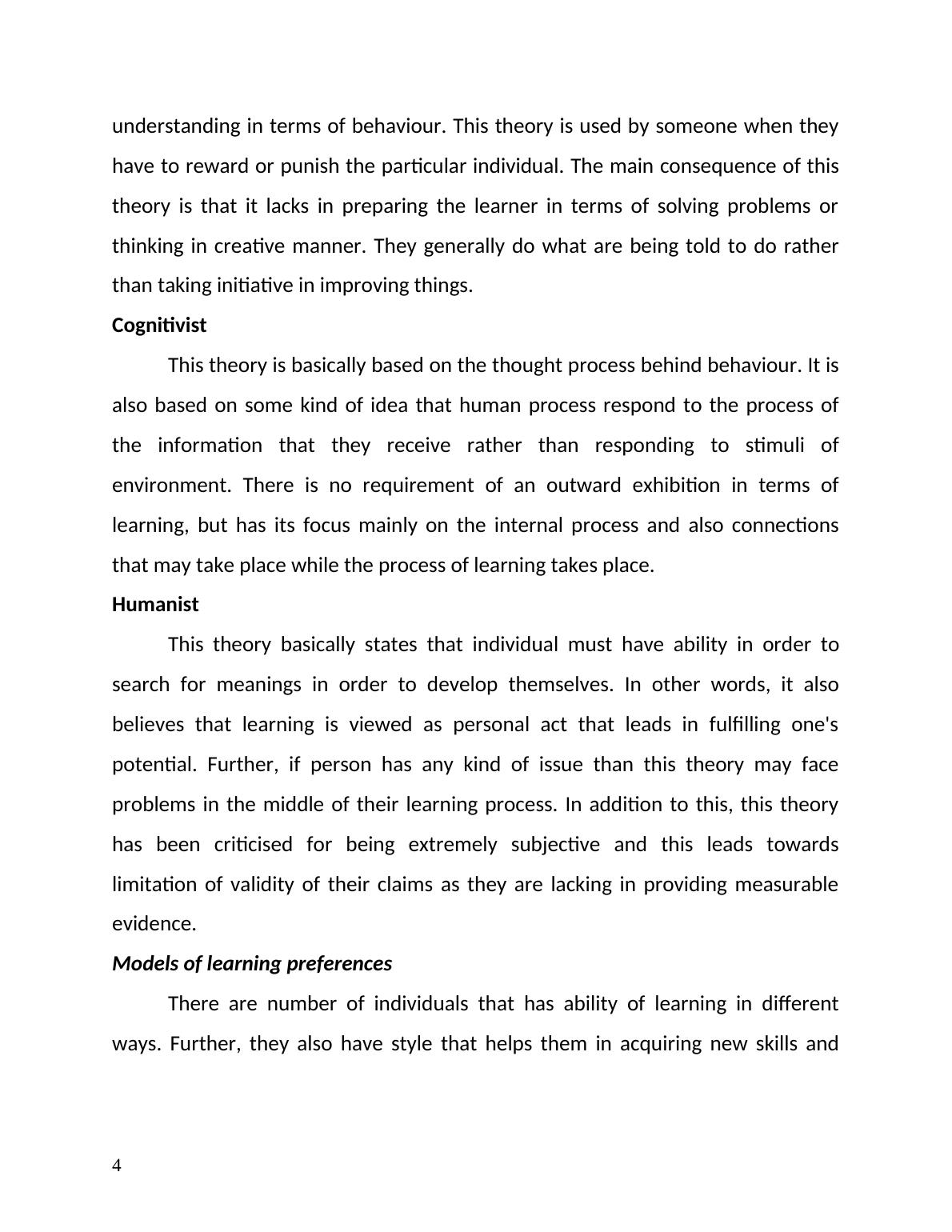
other words, it also believes that learning is viewed as personal
act that leads in fulfilling one's potential. Further, if person has
any kind of issue than this theory may face problems in the
middle of their learning process. In addition to this, this theory
has been criticised for being extremely subjective and this leads
towards limitation of validity of their claims as they are lacking in
providing measurable evidence.Models of learning preferences
There are number of individuals that has ability of learning in
different ways. Further, they also have style that helps them in
acquiring new skills and knowledge so that they can remember
things easily. Thus, some of the learning styles or preferences has
been discussed as per below context-
VARK learning style
VARK style leads in providing with simple ways that helps in
explaining and understanding styles related to learning. It has
been stated that different person has different style in terms of
learning things (Dainton and Zelley, 2017). All methods are used
by learners in order to receive correct information. Thus,
according to this model, there are many people that possess
dominant style in terms of learning. In addition to this, it has also
been stated through this model that an individual may prefer one
style of learning for one task and may use other all with a
combination to perform any other task. Thus, the acronym of
VARK is Visual, Auditory, reading and Kinaesthetic learning.
5
act that leads in fulfilling one's potential. Further, if person has
any kind of issue than this theory may face problems in the
middle of their learning process. In addition to this, this theory
has been criticised for being extremely subjective and this leads
towards limitation of validity of their claims as they are lacking in
providing measurable evidence.Models of learning preferences
There are number of individuals that has ability of learning in
different ways. Further, they also have style that helps them in
acquiring new skills and knowledge so that they can remember
things easily. Thus, some of the learning styles or preferences has
been discussed as per below context-
VARK learning style
VARK style leads in providing with simple ways that helps in
explaining and understanding styles related to learning. It has
been stated that different person has different style in terms of
learning things (Dainton and Zelley, 2017). All methods are used
by learners in order to receive correct information. Thus,
according to this model, there are many people that possess
dominant style in terms of learning. In addition to this, it has also
been stated through this model that an individual may prefer one
style of learning for one task and may use other all with a
combination to perform any other task. Thus, the acronym of
VARK is Visual, Auditory, reading and Kinaesthetic learning.
5

Visual- this style involves that person or an individual
basically learns wither by seeing or observing things.
These things include diagrams, demonstrations, displays,
handouts films etc. they most effectively relate to the
written information and has ability of remembering faces
rather than names.
Auditory- This style involves transferring information from
one person to another with help of listening. They
basically listen to the words that has been spoken by
them or either sounds and noises. This type of person
remember names rather than faces. They are the one who
may be good in writers, graphic design, etc.
Reading- they are the one who are good at reading and
learning things with help of reading and writing. They
have the ability of reading things.
Kinaesthetic- this type of learning style involves physical
experience that includes touching, feeling, holding or
practical hand on experiences. They are those individuals
who enjoy playing games and gets physically involved in
various things. In addition to this, they remember what
was done rather than seeing or talking about that.
KOLB learning style
o Kolb learning style is opposite from Vark learning style.
This is because the KOLB style or preference basically
focus on perception and processing (Fogel, 2017).
According to this style, it has been stated that
6
basically learns wither by seeing or observing things.
These things include diagrams, demonstrations, displays,
handouts films etc. they most effectively relate to the
written information and has ability of remembering faces
rather than names.
Auditory- This style involves transferring information from
one person to another with help of listening. They
basically listen to the words that has been spoken by
them or either sounds and noises. This type of person
remember names rather than faces. They are the one who
may be good in writers, graphic design, etc.
Reading- they are the one who are good at reading and
learning things with help of reading and writing. They
have the ability of reading things.
Kinaesthetic- this type of learning style involves physical
experience that includes touching, feeling, holding or
practical hand on experiences. They are those individuals
who enjoy playing games and gets physically involved in
various things. In addition to this, they remember what
was done rather than seeing or talking about that.
KOLB learning style
o Kolb learning style is opposite from Vark learning style.
This is because the KOLB style or preference basically
focus on perception and processing (Fogel, 2017).
According to this style, it has been stated that
6
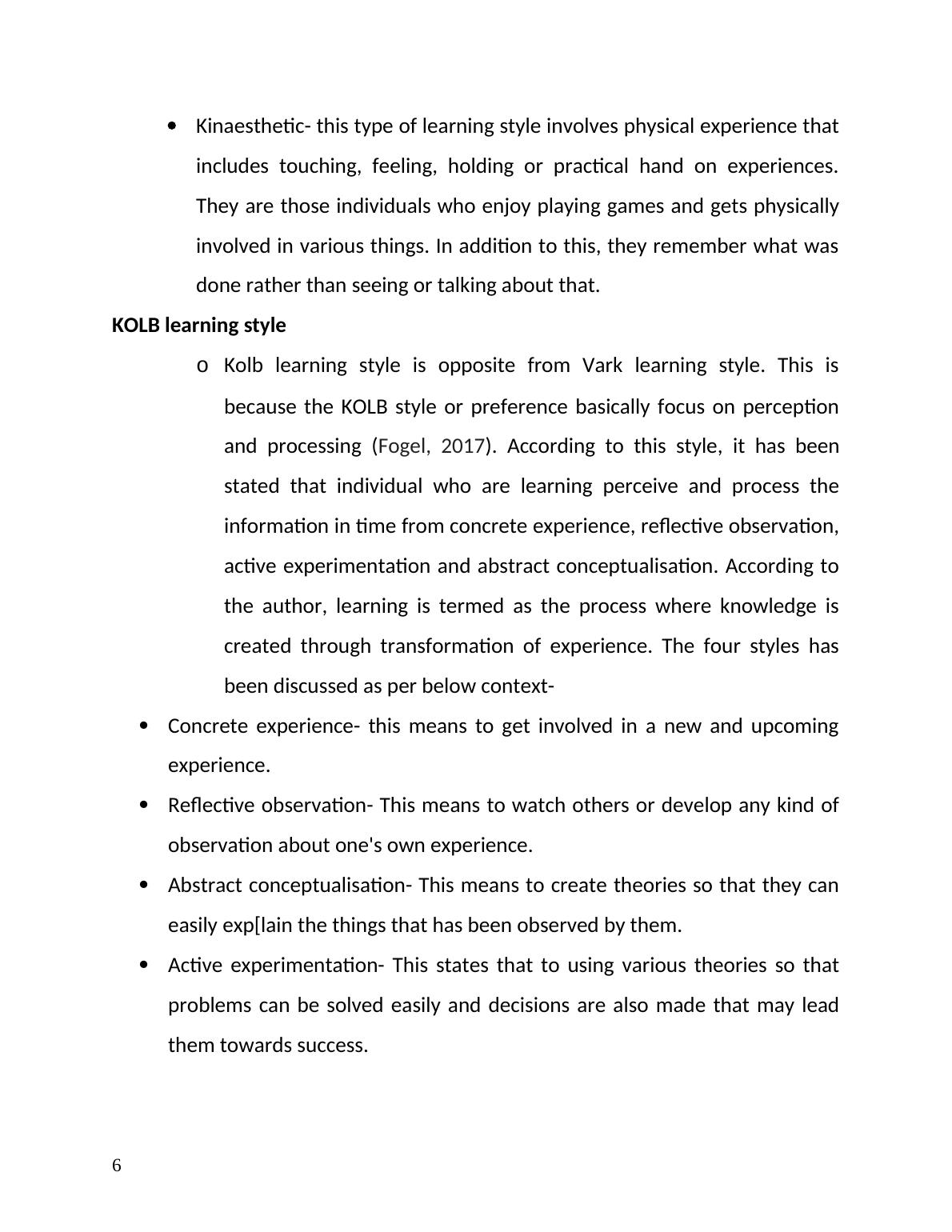
individual who are learning perceive and process the
information in time from concrete experience, reflective
observation, active experimentation and abstract
conceptualisation. According to the author, learning is
termed as the process where knowledge is created
through transformation of experience. The four styles
has been discussed as per below context-
Concrete experience- this means to get involved in a new
and upcoming experience.
Reflective observation- This means to watch others or
develop any kind of observation about one's own experience.
Abstract conceptualisation- This means to create theories so
that they can easily exp[lain the things that has been
observed by them.
Active experimentation- This states that to using various
theories so that problems can be solved easily and decisions
are also made that may lead them towards success.
B. Explaining ways in which theories, principles and models of
learning can be applied to teaching and assessment
They would have used behaviourism theory as they are
playing role of role play interviews (Bates, 2019). In which same
similar questions are asked to everyone so that they can easily
build answer that will lead them in facing them confidently and
also in natural way to all the questions that will be asked to them.
Thus, there are number of ways that are discussed in which the
models and theories of learning are applied.
7
information in time from concrete experience, reflective
observation, active experimentation and abstract
conceptualisation. According to the author, learning is
termed as the process where knowledge is created
through transformation of experience. The four styles
has been discussed as per below context-
Concrete experience- this means to get involved in a new
and upcoming experience.
Reflective observation- This means to watch others or
develop any kind of observation about one's own experience.
Abstract conceptualisation- This means to create theories so
that they can easily exp[lain the things that has been
observed by them.
Active experimentation- This states that to using various
theories so that problems can be solved easily and decisions
are also made that may lead them towards success.
B. Explaining ways in which theories, principles and models of
learning can be applied to teaching and assessment
They would have used behaviourism theory as they are
playing role of role play interviews (Bates, 2019). In which same
similar questions are asked to everyone so that they can easily
build answer that will lead them in facing them confidently and
also in natural way to all the questions that will be asked to them.
Thus, there are number of ways that are discussed in which the
models and theories of learning are applied.
7
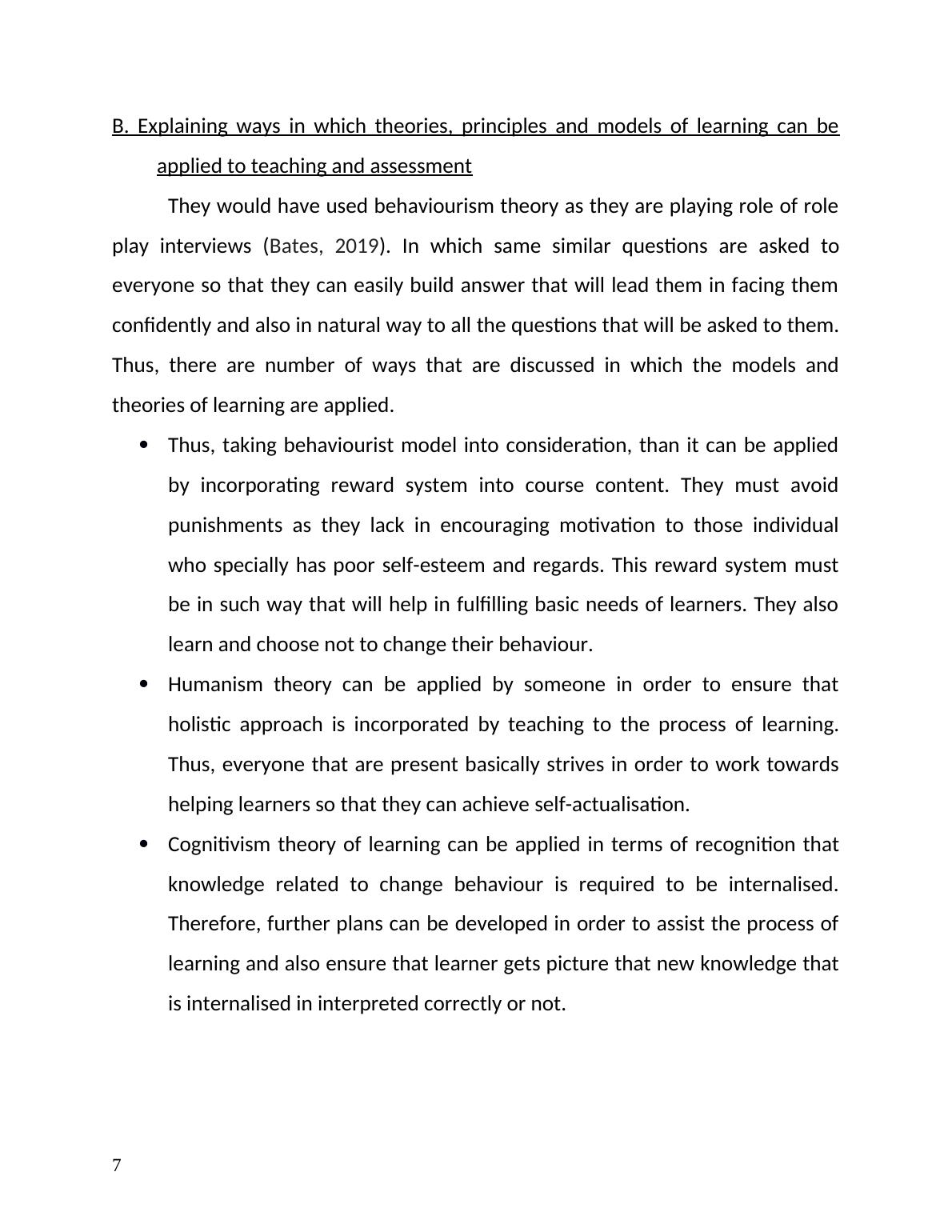
Thus, taking behaviourist model into consideration, than it
can be applied by incorporating reward system into course
content. They must avoid punishments as they lack in
encouraging motivation to those individual who specially has
poor self-esteem and regards. This reward system must be
in such way that will help in fulfilling basic needs of learners.
They also learn and choose not to change their behaviour.
Humanism theory can be applied by someone in order to
ensure that holistic approach is incorporated by teaching to
the process of learning. Thus, everyone that are present
basically strives in order to work towards helping learners so
that they can achieve self-actualisation.
Cognitivism theory of learning can be applied in terms of
recognition that knowledge related to change behaviour is
required to be internalised. Therefore, further plans can be
developed in order to assist the process of learning and also
ensure that learner gets picture that new knowledge that is
internalised in interpreted correctly or not.
C. Analysing individual learning preferences that enables inclusive
teaching, learning and assessment.
Individual learning preference will influence importantly to
the model that will be further applied towards the methods that is
related to teaching. Further, the key features in inclusive teaching
and learning includes assessing needs of an individual, their
8
can be applied by incorporating reward system into course
content. They must avoid punishments as they lack in
encouraging motivation to those individual who specially has
poor self-esteem and regards. This reward system must be
in such way that will help in fulfilling basic needs of learners.
They also learn and choose not to change their behaviour.
Humanism theory can be applied by someone in order to
ensure that holistic approach is incorporated by teaching to
the process of learning. Thus, everyone that are present
basically strives in order to work towards helping learners so
that they can achieve self-actualisation.
Cognitivism theory of learning can be applied in terms of
recognition that knowledge related to change behaviour is
required to be internalised. Therefore, further plans can be
developed in order to assist the process of learning and also
ensure that learner gets picture that new knowledge that is
internalised in interpreted correctly or not.
C. Analysing individual learning preferences that enables inclusive
teaching, learning and assessment.
Individual learning preference will influence importantly to
the model that will be further applied towards the methods that is
related to teaching. Further, the key features in inclusive teaching
and learning includes assessing needs of an individual, their
8

End of preview
Want to access all the pages? Upload your documents or become a member.
Related Documents
Unit 502: Theories, Principles and Models in Education and Traininglg...
|19
|6736
|471
Theories, Principles, and Models of Learning in Education and Traininglg...
|19
|6448
|30
Models and Theories of Learning, Communication, Assessment, Curriculum Development and Reflectionlg...
|19
|6521
|185
Models for Learning, Communication, Assessment and Curriculum Developmentlg...
|20
|6570
|89
Theories, Principles and Models in Education & Traininglg...
|23
|8515
|438
Theories, Principles, and Models in Education and Traininglg...
|13
|4185
|74
